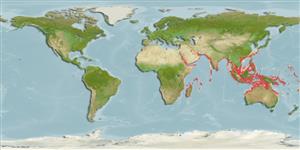Environment: milieu / climate zone / depth range / distribution range
Écologie
marin; saumâtre démersal; amphidrome (Ref. 51243); profondeur 45 - 90 m (Ref. 68964). Tropical
Indo-West Pacific: southern Arabian Sea and Bay of Bengal through Malaysia, Indonesia to Bali and Celebes, Gulf of Thailand, Viet Nam, Hong Kong and southern Philippines. Also reported from the Arafura Sea (Ref. 9819). Records from the northern Arabian Sea, Persian Gulf and east coast of Africa probably refer to other species.
Taille / Poids / Âge
Maturity: Lm ? range ? - ? cm
Max length : 30.0 cm TL mâle / non sexé; (Ref. 9790); common length : 20.0 cm TL mâle / non sexé; (Ref. 9790)
Épines dorsales (Total) : 9; Rayons mous dorsaux (Total) : 11 - 13. Lateral line scales often 53, each scale with a backward directed spine that extends beyond rear margin of scale, especially along the caudal peduncle. Interorbital width 9% or more of head length.
Taken by trawling over mud and sand at depths to about 55 m (Ref. 9790). Juveniles may enter brackish water.
Life cycle and mating behavior
Maturité | Reproduction | Frai | Œufs | Fécondité | Larves
Kuronuma, K. and Y. Abe, 1986. Fishes of the Arabian Gulf. Kuwait Institute for Scientific Research, State of Kuwait, 356 p. (Ref. 5999)
Statut dans la liste rouge de l'IUCN (Ref. 130435: Version 2024-2)
Menace pour l'homme
Harmless
Utilisations par l'homme
Pêcheries: intérêt commercial mineur
Outils
Articles particuliers
Télécharger en XML
Sources Internet
Estimates based on models
Preferred temperature (Ref.
123201): 23.3 - 28.3, mean 27.2 °C (based on 347 cells).
Phylogenetic diversity index (Ref.
82804): PD
50 = 0.6250 [Uniqueness, from 0.5 = low to 2.0 = high].
Bayesian length-weight: a=0.00550 (0.00314 - 0.00962), b=3.07 (2.91 - 3.23), in cm total length, based on LWR estimates for this species & (Sub)family-body (Ref.
93245).
Niveau trophique (Ref.
69278): 3.8 ±0.6 se; based on size and trophs of closest relatives
Résilience (Ref.
120179): Milieu, temps minimum de doublement de population : 1,4 à 4,4 années (Preliminary K or Fecundity.).
Fishing Vulnerability (Ref.
59153): Low vulnerability (20 of 100).
